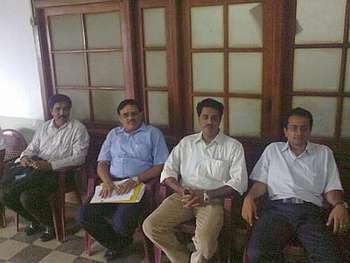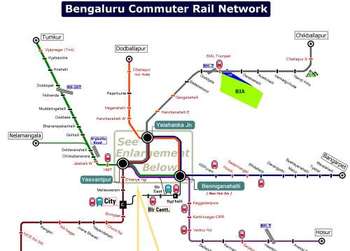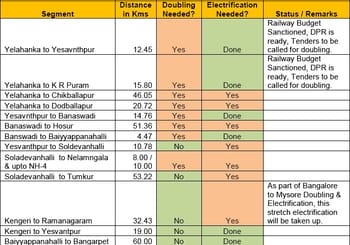Did you know that rail connectivity already exists between KR Puram and Electronic City? Or between Whitefield and Yeshwantpur?
Bangalore has grown so large over the past decade that many peri-urban South-Western Railway stations are now within the greater Bangalore region. The prospect of introducing commuter trains between major city hotspots located along SW Railway’s network has therefore been attractive to many and increasingly so today, with Bangalore’s worsening road traffic situation.
[Click on Image to Enlarge]. Praja and CiSTUP’s report proposes these routes for commuter rail services. Image courtesy: Bengaluru Commuter Rail Service, Call to Action, July 2010
But even as the state government is in talks with the South Western Railways (SWR) to introduce local trains in Bangalore, the latter has stated that the load on their network is more than full, with no space for new services.
On September 23rd 2010, the state Chief Secretary S V Ranganath called for a meeting to discuss Commuter Rail Services (CRS), inviting officials of SWR, Infrastructure Development Department (IDD) and Urban Development Department (UDD). Also, present were members of Praja.in (an online citizen community) and CiSTUP (Centre for Infrastructure, Sustainable Transport and Urban Planning, Indian Institute of Science).
Both Praja.in and CiSTUP have been campaigning for over a year now, to introduce CRS in Bangalore. In July 2010, they prepared a Call to Action Report and in August 2010 organised a Namma Railu event to discuss the same. They have now prepared a Terms of Reference (ToR) to prepare the Detailed Project Report (DPR) for CRS as well.
The September 23rd meeting was called by Ranganath to kick-off the process towards preparing a DPR for CRS. Details of this meeting are available here
For many years now, the SWR has not openly supported CRS. Speaking to Citizen Matters, SWR’s Divisional Railway Manager (DRM), S Mani, says, “We are not an organisation meant to do CRS. The state government is not asking us to do it. They are asking us if we can bear it. Can we? No.”

South Western Railway’s Divisional Railway Manager S Mani. Pic: Vaishnavi Vittal.
But the state government, in particular, V Madhu, Principal Secretary, IDD and Revenue Department, has been asking if the Indian Railways (IR) has any objection to preparing a DPR for this. It was for this reason that Madhu rquested the Chief Secretary to call for a meeting, which happened on September 23rd. Mani says that prima facie the SWR has no objections to the preparation of a study. “To what extent our help is required for this, depends on the proposal”, he adds.
At the meeting, Ranganath also announced that he would speak to the Chairman of the Railway Board during his next trip to Delhi, as his office would make the final decision for the railways.
27-year wait for commuter rail, and still counting
It was in 1983 when, ironically, the Railways mooted the idea of commuter rail for Bangalore and recommended three commuter rail lines and a 58-km ring railway over a 25-year period. Even today, the Railways clearly state that CRS is required for Bangalore. “Whether the existing infrastructure is designed to handle this? No. If augmented, will it be able to handle? We’ll have to see”, explains Mani. He also explains that CRS should be independent of long-distance trains, but could allow streaming and linking with their stations.
Members of Praja.in who prepared the Call for Action report in July 2010 along with CiSTUP say that CRS will initially not concentrate on Bangalore City station, Cantonment and Byappanahalli because of the known challenges in this segment. They are instead asking for local trains to be introduced along the following routes at a frequency of about 20 trains per day along each route.
|
Route |
Distance (kms) |
|
Yeswantpur – Yelahanka – Devanahalli – Chickballapur |
60 |
|
Benninganahalli – Thanisandra – Yelahanka – Doddballapur |
37 |
|
Yeswantpur – Benninganahalli – Anekal – Hosur |
66 |
|
Tumkur/Nelamangala – Yeshwantpur – Benninganahalli |
83 |
|
Yelahanka – Benninganahalli – Whitefield – Malur – Bangarpet |
80 |
|
Yelahanka – Yeshwantpur – City – Kengeri – Ramanagara |
50 |
|
Total route length (kms) |
376 |
Source: Bengaluru Commuter Rail Service, Call to Action, July 2010
The study estimates that about 45 lakh people live along the above existing tracks. “About 1/3rd of this population are (sic) not served because of lack of stations and last mile within local areas. These 33% consequently move to other modes like private transport to fulfill their commuting needs, putting further pressure on roads”, says the report.
DRM’s Mani however reiterates that with 180 passenger trains and 40-45 goods trains running everyday to and from Bangalore, their network is already full. “Requests for ten more trains are still pending”, he says.
However, Sathya Sankaran, a member of Praja who prepared the report and also attended the September 23rd meeting, says SWR is not utilizing tracks to the optimum. “Trains are parked on the main track. It is because of this that they are unable to manage their schedule.” Sankaran, a resident of Sanjaynagar in north Bengaluru, is an Associate General Manager with HCL Technologies.

Praja and CiSTUP members wait at Vidhana Soudha on September 23rd before the meeting. From left to right, Sanjeev V Dyamannavar (Praja), Prof T G Sitharam (CiSTUP), Capt Naveen Chandra (Praja), and Sathya Sankaran (Praja). Pic courtesy: www.praja.in/en/nammarailu
Sankaran also says the railways will have to introduce an updated signaling system to reduce headway and increase capacity. Doubling tracks and quadrupling of tracks, electrification, optimized routing and consolidation including train rescheduling, dedicated platforms at key stations and dedicated tracks for CRS are some of the requirements to increase capacity in view of commuter rail.
“You have trains that are at a platform for two hours, three hours, even six hours. That has to stop. For this an attitudinal change also needs to come from the citizens’ side”, he says.
Apart from the new routes that the report has proposed, it also recommends the use of some rapid interstate and slow passenger services. The report identifies 14 pairs of trains that can also be brought under the ambit of commuter rail for optimal utilization and to avoid duplicate services. See the list here
Citizens propose setting up of Bengaluru Commuter Rail Authority
For all this, Praja and CiSTUP recommend the setting up of a Special Purpose Vehicle or SPV called Bengaluru Commuter Rail Authority Ltd (BCRAL) consisting of the following stakeholders: IDD representing the state government and citizens as majority partners, Rail Vikas Nigam Ltd representing the IR, BMTC for bus last mile connectivity and BMRC (Bangalore Metropolitan Rail Corporation) for Namma Metro integration.
[Click on Image to Enlarge].Praja.in and CiSTUP’s report shows the track status of each proposed route. Image Courtesy: Bengaluru Commuter Rail Service, Call to Action, July 2010
So once the DPR has been prepared, mentioning the setting up of the SPV, instituting this body could be one of the first step towards implementing CRS. As of now, no decision has been taken about funding of the project, though talks have emerged about public-private partnership (PPP). The ToR says the DPR will have to make a financial analysis and explore the option of private sector participation.
Sankaran says the DRM seemed for the idea of a PPP model at the meeting called by the Chief Secretary. “He was okay if the SPV wanted to have complete operational freedom as long as a fee was apportioned to IR”, says a post on Praja.in.
At the Namma Railu event organised by Praja.in and CiSTUP on August 30th 2010, IDD’s Madhu had said that SWR had earlier agreed to run trains on existing lines if land was acquired and given to them.
Right now, it’s the formal consent of the railways that is required to green signal this project. The next step would be to prepare a DPR, which the ToR says should be prepared by a team consisting of one financial analyst with over 15 years of related experience, one specialist in private sector participation, who is familiar with the working of the railways, with over 15 years of related experience, and one specialist in railways with over 15 years of related experience in technical & economic aspects of running railway services.
For commuters looking to hop on, this isn’t exactly doing to happen tomorrow. Stay tuned however, since the wheels of bureaucracy are finally moving.
Sequence of events
1983 – Southern Railway team recommends 3 commuter rail lines and a 58-km ring railway over a 25-year period
1988 – RITES transport study report reiterated improvements to commuter rail lines
1993 -State established committee to look into mass rapid transit recommended the same circular railway put forward by Southern Railways in 1983
1998 – RITES does survey for Local Trains funded by World Bank
2003 – RITES completes survey for Local Trains for state government
2007 – RITES completes survey for commuter rail as part of CTTP 2007, recommending an extensive commuter rail network for Bengaluru and nearby towns
January 2008 – IDD agrees to fund for two Rakes DEMU services
November 2009 – BMLTA assigns work to IDD to study Commuter Rail services connecting all peripheral stations.
December 14th 2009 – At a BMLTA meeting, SWR agrees to start few local trains to Anekal/Devanahalli, Kengeri
January 2nd 2010 – Minister of State (Railways) K H Muniyappa announces commencement of local trains between Yeshwanthpur to Anekal and Devanahalli
February 2010 – Bengaluru South MP H N Ananth Kumar request the MoS Railways to take up local train facility similar to Mumbai
March 3rd 2010 – Chief Minister B S Yeddyurappa writes to Railway Minister Mamata Bannerjee to sanction the Local Train Project with 50% project cost to be contributed by the state government
July 2010 – Praja.in and CiSTUP prepare a Call to Action report for Bengaluru Commuter Rail Service
August 2010 – Namma Railu event, jointly organised by Praja.in and CiSTUP at the Indian Institute of Science, saw officials of south-western railway, IDD, BMRCL, BMTC and the chief minister’s office in attendance.
September 2010 – Praja.in and CiSTUP prepare a Terms of Reference for the Detailed project Report
September 23rd 2010 – Chief Secretary S V Ranganath holds a meeting with state government and south-western railway officials. Meeting concludes with decision to hold a meeting with the Railway Board
This chronology is partially sourced from the July 2010 Call to Action report prepared by Praja.in and CiSTUP.
⊕
Related Articles


This is a fantastic effort, guys. And the quality of analysis is just superb. Our government and the IAS officers running Bangalore, and those planning (?) for its growth should have been doing this type of work. Other readers, please read the “Call to action” PDF report embedded as a link in the article. The main tricky factor is the potential involvement of the Indian Railways – with its baggage of ministers like Mamata Banerjee, who have questionable short term agendas. Also the quality of the commuter service, which has to share track with long distance trains may be compromised. So these proposals should consider major investment in additional (parallel) track which will increase capacity and can offer dedicated lines; Further land acquisition will not be a major problem as the IR already has railway track there. Thanks again to Praja and please keep up the great work.
The SWR DRM claims that their network is full. But you can find the platforms in Yeshwantpur and City laying vacant for most part of the day. Railways has surplus land in and around the city where doubling of tracks can easily be done. Doing this the Railways are at profit. When the State Govt. is ready to foot 50% of the expenses, SWR can take this task as a priority and implement circular rail network for Bangalore City and its adjoining townships.
Its CiSTUP & Praja have taken up the issue for Public to get the better Transport Facility with less project cost and within short time, this Commuter Rail can be rolled out.
With METRo, BMTC & Commuter Rail, Bangalore city & its surrounding Traffic issues will be reduced to larger extent.
Thanks to Vaishnavi Vittal & Citizen Matters for Covering the such detailed report based on the Commuter Rail Call to Action Report.
Citizens of Bangalore should ask their area MLA and MP’s to get the Commuter Rail for Bangalore at the earliest.
This is an extremely informative article. I personally suffer from the traffic woes to the extent of travelling 5 hours a day. Also an observation, is that the Bangalore roads are not saturated but completely choked. Any amount of efforts on the road route will not be a permanent solution. We would need to look at alternatives like tha CRS. I have always wish and prayed for a service like this. This would mean so much to people like me, who commute from faraway places to work..shuttling between 2 buses and autos and still spend 5 hours a day. Look forwards to more information on this.I really hope and wish the efforts or Praja and CiSTUP are fruitful ASAP.